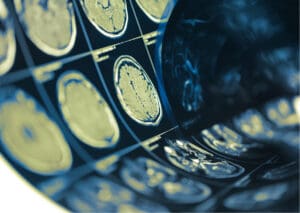By ECTRIMS Contributing Writer Stefania de Vito

Our brain boasts an extensive web of neural pathways. Cognition and behaviour hinge upon the interactions of neurons situated in different brain regions, which are anatomically connected and communicate through coordinated activity [1]. In individuals with MS, the structural and functional integrity of brain networks is substantially altered.
Axonal pathways do not survive persistent states of demyelination. The disruption of white matter tracts entails potentially detrimental effects on the distinct brain areas they are connecting [2]. Identifying the brain activity markers that define the clinical progression of MS may have relevant implications for the clinical characterisation and treatment targets, potentially improving patient care.
 The hypothesis of the “network collapse”: Toward a network-focused conceptual framework?
The hypothesis of the “network collapse”: Toward a network-focused conceptual framework?
A central hypothesis in recent years considers the clinical progression of MS as the result of a “network collapse” [3]. To elucidate this concept, the London Underground offers a helpful analogy. How many lines of the Tube can be disrupted before the transportation network collapses? In early stages of MS, functional activity can increase following subtle structural damage [4]. And even structural reorganisation can evolve with disease onset [5]. These processes of network reorganisation presumably represent mechanisms to compensate for ongoing focal damage. This compensation is an attempt to preserve normal function. As disability progresses and structural damage spreads throughout the brain and becomes more severe, there is a progressive loss of key structural connections. Imagine the Victoria line is interrupted, and travellers still need to reach King’s Cross and St. Pancras. The traffic needs to reconfigure around this central hub. People struggle to enter the train, some of them are left behind. The hub becomes constantly overcrowded and remarkably disrupted. A similar situation may occur in the brain of individuals with MS. The increased functional connectivity reroutes around crucial network structures (i.e., “hubs”). These hubs become overloaded, hence, rigid, and less adaptable. The interplay between brain networks is disrupted. The wiring of the network becomes less efficient, up to a critical threshold beyond which the network collapses. This determines an acceleration of clinical progression.
 Monitoring brain function: Clinical implications
Monitoring brain function: Clinical implications
Different brain centers investigate which functional markers have a higher potential to be considered in clinical trials or as a treatment target. In a recent interview, Menno Schoonheim, associate professor at the Amsterdam UMC, told us “For a long time, studies on MS have been cross-sectional. Large cohorts have been examined only at one specific point of time. Many brain centers now, including ours, are focusing on longitudinal studies of cohorts. The advantage is that we can start to measure the same patients earlier and follow them overtime, considering multiple time points. This helps to understand what happens at a functional level once the network collapses, but also what happens before”. Emerging evidence suggests disease-stage specific processes. During the early stages of MS the ventral attention network (VAN) has been observed to increase before eventually progressing toward cognitive impairment [6]. In patients with more severe cognitive impairment this network change transitions towards the default-mode network (DMN) and the thalamus [7]. In MS patients with progressing fatigue structural network hubs were identified in the basal ganglia and pons [8]. All these structures play a pivotal role in regulating the flow of information through cerebral networks during specific situations. The VAN modulates the switch between the frontal-parietal network (FPN), which orients attention on external stimuli, and the DMN, more dominant during internally oriented processes. “Imagine an orchestra, where the VAN is the conductor”, continues Schoonheim, “the conductor regulates the dominance of the different instruments, deciding whether the trombone or the piano have to be louder in different moments. This conductor is more and more under pressure as people progress in their pathology, and we hypothesise that at some point the conductor just leaves building. At this point the network destabilises and collapses. This means that we have to monitor the conductor to predict how far along a patient is toward an eventual collapse”. Monitoring the flexibility of the DMN and the VAN can be crucial to prevent potential collapse.
Understanding brain lesions through measures of brain activity
The existence of a discrepancy in MS between visible lesions on MRI and neurological and cognitive impairment is well known as the clinico-radiological paradox [9]. Differences in clinical expression of MS are not only driven by brain structure. Despite similar lesions, some patients can better preserve their brain function than others. This has been linked to the notion of cognitive reserve [10]. Measures of brain activity could, therefore, help to better stratify patients based on their risk of progression. In line with current trends in medicine, these observations encourage to develop a biologically grounded framework [11]. This may help tailor individual treatments to patients.
REFERENCES
[1] Fries P. Neuron 2015; 88(1): 220-235.
[2] Azevedo C, et al. Ann Neurol. 2018; 83(2): 223-234.
[3] Schoonheim MM, Broeders TAA, and Geurts JJG. NeuroImage Clin. 2022; 103108.
[4] Faivre A, et al. Mult. Scler. 2016; 22(13): 1695-1708.
[5] Fleischer et al. Neurosci. 2019; 403: 35-53
[6] Huiskamp M, et al. Neurol. 2021; 97(8): e794-e802.
[7] Dekker I, et al. NeuroImage Clin. 2021; 29: 102550.
[8] Fleischer et al. Ann. Neurol. 2022; 91:192-202
[9] Chard DT, et al. Nat. Rev. Neurol. 2021; 17(3): 173-184.
[10] Stern, Y. Neuropsychologia 2009; 47(10): 2015-2028.
[11] Kuhlmann T, et al. Lancet Neurol. 2023; 22(1): 78-88.